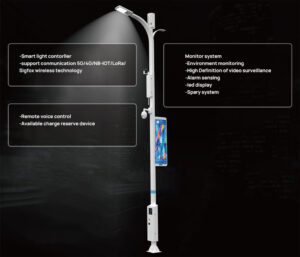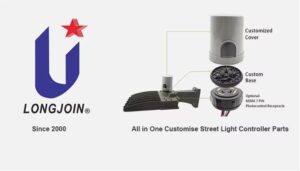How Does Lux Value Affect The Performance Of A Photocontroller?
introduction
People are becoming inclined towards saving energy. Energy conservation is our duty as responsible members of society. It brings benefits to yourself, and society. Growing attention towards energy efficiency has made Zhaga photocells a popular demand. Unlike traditional photocells, they work by saving energy. It has made outdoor lighting easier, and affordable.
Lux Value
Before we look into how lux value impacts phone controllers, we will get the concept of what lux value is. Lux is the unit of measurement for illuminance or brightness given by any light. It is the amount of light that falls on a surfacer that is detected by the human eye. Humans perceive brightness as high or low, but the lux value can give a tangible measurement for illuminance. This means that the lux value is higher outdoors in the sun, and lower in a dim room.
Lux services from the word Candela, which is the standard unit for the measurement of light power. It equals the brightness given by one candle. Candela is a unit of energy, yet it has an equivalent, lumen. Lumen measures light as perceived by the human eye. Lux also considers the surface area where the light strikes. One lux is one lumen on an area of one square meter.
What are Zhaga Photocells?
Now that you are aware of lux value, we will understand how it impacts photocells. Photocells use the lux readings to control the operation of any lighting system. The principle is easy- when the lux value is low, the photcontroller will switch on the lights. Lux value decreases as the day sets, or when the weather conditions make the environment dimmer.
The opposite happens when the lux value goes higher. On a bright sunny day, the lux value is extremely high, so the photocells would switch off the lights. This is how the lights of shopping malls or streets operate automatically!
How is Lighting Measured?
Caption: Digital electronic Photocontroller
Lighting can be measured through two devices, a Lux meter, or a foot-candle meter. The Lux meter is more commonly used as it measures light as perceived by human eyes. The light perceived by humans is different from the light produced by a source.
Lux mater has a sensor, usually a photocell or a photodiode that captures light from the surroundings. It produces electrical current proportional to the amount of light falling on it. Current gives an electrical signal that is measured to get the lux value of the light.
The Digital electronic photo controller displays the illuminance value on its digital or analog screen. Illuminance is calculated by dividing total luminous flux (measured in lume) by the area over which the light strikes(measured in square meters).
How to Calculate Illuminance by a Lux Meter?
To calculate illuminance at a specific distance from a light source, you can follow these steps:
- Figure out the area of the sphere at that particular distance from the source:
- Square the distance and multiply it by Pi (π).
- Multiply the result by four to obtain the surface area of the sphere.
- Divide the light concentration in lumens by the spherical area calculated in step 1. This gives you the illuminance in lux. If your measurement is in feet, the answer you get would be in foot candles.
- You may need to apply a correction factor if the light reaches the surface at an angle less than 90 degrees. Multiply the computed illuminance value by the cosine of the off-axis angle.
Here’s a breakdown of the calculation process:
- Area = 4 x Pi x (Distance2)
- Illuminance calculation of light concentration in lumens/ area of a sphere
- Correction factor (if required); illuminance x cos (Off-axis angle)
Note: Use consistent units throughout the calculation (e.g., feet for distance if foot candles are desired, and meters for lux). Also, remember to convert the off-axis angle to radians if necessary before taking the cosine.
Luxmaters are capable of measuring lights of varying intensities. They can detect extremely dim lights and very bright sunlight. Their sensitivity is based on the model you choose. For outdoor places, you can try out this photocell sensor.
Optimal Lux Values for Different Environments
The lighting level required in every environment differs. Streetlights in a residential area and streetlights in a marketplace need different lighting levels. If streetlights outside your house glow too brightly, it may cause a disturbance. Hence, the lux value does more than control lighting operation. Lux value thresholds are set for parks, commercial areas, and residential areas.
They operate based on the adjusted settings. For example, on a busy road, the lux value is adjusted to provide sufficient lighting for drivers to see properly. The lux value of residential areas has the highest lux value threshold. His way places can be illuminated automatically with the use of photocontrollers.
How Lux Senetivty Impact Photocotroller?
Lux sensitivity is the responsiveness of a photocontroller to changes in illuminance. The sensitivity of a photocontroller is crucial to get accurate readings. It impacts its performance and effectiveness. If the entirety of a photo controller is high, it reacts rapidly to slight changes in light. It gives precise control over lighting activation by photocontroller.
Lux sensitivity is impacted by photocontrollers’s sensors. Advanced sensors that incorporate the latest technologies are far better than traditional sensors in detecting light levels. They usually have photodiodes or phototransistors to convert light into electrical signals.
Note: Extremely high lux sensitivity can trigger false results. Lighting can fluctuate by the passing of clouds or vehicles nearby. It can affect the efficiency of the system.
Energy Efficiency of Photocontrollers
Using a photocontroller for lighting systems has numerous benefits. The primary advantage is the contribution to energy efficiency. It automatically adjusts lighting based on surroundings. It minimizes energy consumption and thus reduces operational costs.
Energy wastage is prevented during day hours by turning off the lighting system. It maximizes energy efficiency. Simulatenosuedly, it provides light wherever it is required. This would also save the environment as less heat energy is released by the light. Studies have shown that properly calibrated photocontrollers can reduce energy consumption by up to 50% compared to conventional lighting systems without automatic control mechanisms.
Since photocontrollers run for a specific time, they can extend their lifetime. Their lifespan is greater than lamps that work throughout the day. It is a suitable cost-effective solution to illuminate your surroundings.
If you want to get a reliable photocell, we are here for you. Feel free to browse through our diversified collection, and get the one that suits your requirements!
FAQs
Can I use the same lux meter for both indoor and outdoor measurements?
Yes, but make sure the lux meter is suitable for the range of illuminance levels you intend to measure, as outdoor environments often have higher light levels.
What factors can affect the accuracy of illuminance measurements?
Factors such as shadows, glare, and reflective surfaces can influence the accuracy of illuminance readings and may require corrections.
Are there any limitations to using lux meters for illuminance measurements?
Lux meters provide accurate measurements under normal conditions, but extreme temperatures, humidity, or highly reflective surfaces may affect their performance and require additional precautions.
Conclusion
Lux value controls the operation of photo controllers. When this value is below the set lux value threshold, the lighting system is switched on by the photocontroller. When this value exceeds the threshold, the lighting system is switched on.
External Link
http://lightingcontrolsassociation.org/2013/09/16/estimating-energy-savings-with-lighting-controls/






